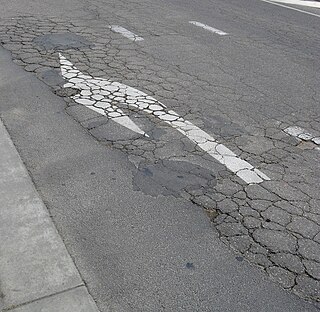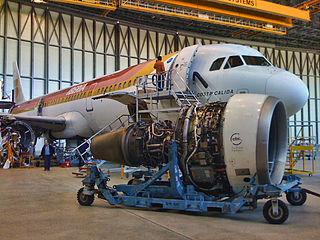In reliability engineering, the term availability has the following meanings:
Total cost of ownership (TCO) is a financial estimate intended to help buyers and owners determine the direct and indirect costs of a product or service. It is a management accounting concept that can be used in full cost accounting or even ecological economics where it includes social costs.
SIA Engineering Company Limited is a Singaporean company specialising in aircraft maintenance, repair and overhaul (MRO) services in the Asia-Pacific. It is a wholly owned subsidiary of the Singapore Airlines Group (SIA), formed in 1992 with the separation of SIA's engineering division.
Reliability engineering is a sub-discipline of systems engineering that emphasizes the ability of equipment to function without failure. Reliability describes the ability of a system or component to function under stated conditions for a specified period. Reliability is closely related to availability, which is typically described as the ability of a component or system to function at a specified moment or interval of time.

A type certificate signifies the airworthiness of a particular category of aircraft, according to its manufacturing design. Certification confirms that the aircraft of a new type intended for serial production is in compliance with applicable airworthiness requirements established by the national air law.
Integrated logistics support (ILS) is a technology in the system engineering to lower a product life cycle cost and decrease demand for logistics by the maintenance system optimization to ease the product support. Although originally developed for military purposes, it is also widely used in commercial customer service organisations.

Aircraft maintenance checks are periodic inspections that have to be done on all commercial and civil aircraft after a certain amount of time or usage. Military aircraft normally follow specific maintenance programmes which may, or may not, be similar to those of commercial and civil operators.
Condition monitoring is the process of monitoring a parameter of condition in machinery, in order to identify a significant change which is indicative of a developing fault. It is a major component of predictive maintenance. The use of condition monitoring allows maintenance to be scheduled, or other actions to be taken to prevent consequential damages and avoid its consequences. Condition monitoring has a unique benefit in that conditions that would shorten normal lifespan can be addressed before they develop into a major failure. Condition monitoring techniques are normally used on rotating equipment, auxiliary systems and other machinery like belt-driven equipment,, while periodic inspection using non-destructive testing (NDT) techniques and fit for service (FFS) evaluation are used for static plant equipment such as steam boilers, piping and heat exchangers.

Predictive maintenance techniques are designed to help determine the condition of in-service equipment in order to estimate when maintenance should be performed. This approach promises cost savings over routine or time-based preventive maintenance, because tasks are performed only when warranted. Thus, it is regarded as condition-based maintenance carried out as suggested by estimations of the degradation state of an item.
Reliability-centered maintenance (RCM) is a concept of maintenance planning to ensure that systems continue to do what their user require in their present operating context. Successful implementation of RCM will lead to increase in cost effectiveness, reliability, machine uptime, and a greater understanding of the level of risk that the organization is managing.
In organizational management, mean down time (MDT) is the average time that a system is non-operational. This includes all downtime associated with repair, corrective and preventive maintenance, self-imposed downtime, and any logistics or administrative delays.
The term downtime is used to refer to periods when a system is unavailable. The unavailability is the proportion of a time-span that a system is unavailable or offline. This is usually a result of the system failing to function because of an unplanned event, or because of routine maintenance.

Aircraft maintenance is the performance of tasks required to ensure the continuing airworthiness of an aircraft or aircraft part, including overhaul, inspection, replacement, defect rectification, and the embodiment of modifications, compliance with airworthiness directives and repair.

Jat Tehnika is a Serbian aerospace company providing aircraft maintenance, repair and overhaul. The company is based at Belgrade Nikola Tesla Airport and provides services for Air Serbia and other airlines across Europe.
Medical equipment management is a term for the professionals who manage operations, analyze and improve utilization and safety, and support servicing healthcare technology. These healthcare technology managers are, much like other healthcare professionals referred to by various specialty or organizational hierarchy names.

Corrective maintenance is a maintenance task performed to identify, isolate, and rectify a fault so that the failed equipment, machine, or system can be restored to an operational condition within the tolerances or limits established for in-service operations.
A spare part, spare, service part, repair part, or replacement part, is an interchangeable part that is kept in an inventory and used for the repair or refurbishment of defective equipment/units. Spare parts are an important feature of logistics engineering and supply chain management, often comprising dedicated spare parts management systems.
Availability is the probability that a system will work as required when required during the period of a mission. The mission could be the 18-hour span of an aircraft flight. The mission period could also be the 3 to 15-month span of a military deployment. Availability includes non-operational periods associated with reliability, maintenance, and logistics.
Integrated vehicle health management (IVHM) or integrated system health management (ISHM) is the unified capability of systems to assess the current or future state of the member system health and integrate that picture of system health within a framework of available resources and operational demand.

The Aerospace Technology Systems Corporation Sdn Bhd (ATSC), is a Malaysian aerospace company that providing aircraft maintenance, repair and overhaul (MRO) service. Its subsidiary of National Aerospace and Defence Industries Sdn Bhd (NADI) and incorporated by Ministry of Finance (MoF).










